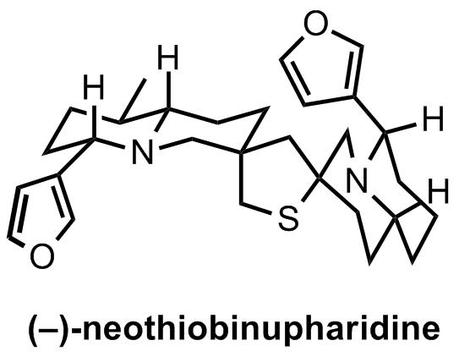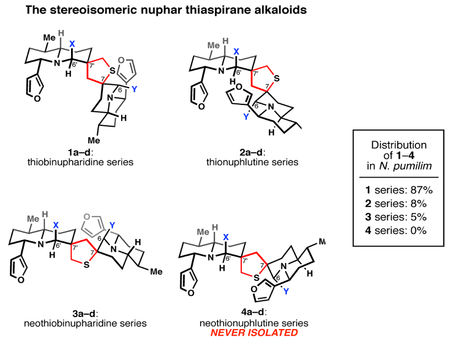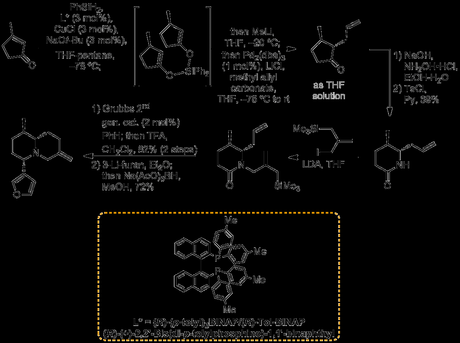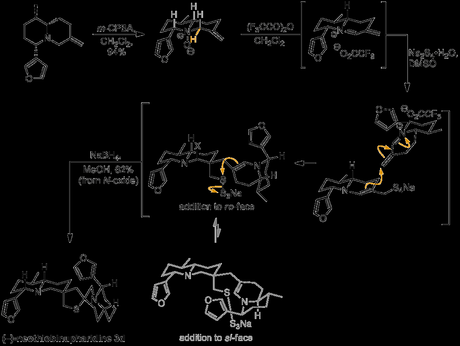I've not written all that many total synthesis posts this year, not for a dearth of interesting work, but more a lack of free time. I started writing this one about six months ago (!), and I guess most of you have probably seen this paper already, but I think it’s pretty cool so I decided it’d be worth finishing. Now featuring my new favourite piece of punctuation, the em dash!
Synthesis of (−)-Neothiobinupharidine
Ryan A. Shenvi et al., J. Am. Chem. Soc., 2013, 135, 1209 [PDF][SI][GROUP]
DOI: 10.1021/ja310778t

The first of the rather wacky looking nuphar alkaloids were actually isolated back in the 60s by Achmatowicz (of Achmatowicz reaction 'fame'), the family has now grown to a fair size, as you can see from the borrowed figure below. No-one paid them much attention for a while, as they weren't very bioactive, looked quite intimidating, and everyone was probably too busy psyching themselves up to make vernolepin anyway.[1] However, a recent report that they selectively kill off melanoma cells (via a mechanism that no-one’s worked out yet), combined with a pretty cool biosynthetic proposal by LaLonde, was enough for Shenvi to spend a little time working out a synthesis.

This figure borrowed from J. Am. Chem. Soc., 2013, 135, 1209. Also, a: X,Y = OH; b: X = OH; Y = H; c: X = H, Y = OH; d: X,Y = H.
First, before we take a look at what he came up with, I’ll quickly show you LaLonde’s biosynthetic proposal for the family, as it’s obviously been a strong influence on Shenvi’s route. The idea is that an extended iminium ion is formed and undergoes addition of a sulfur nucleophile (e.g. tetrasulfide) to give an enamine that then reacts with another molecule of iminium starting material in a Mannich-type process. Intramolecular sulfenylation (i.e. C–S bond formation) of the enamine then forms the central tetrahydrothiophene ring, and the leftover iminium ions are trapped out by water (or hydride) to give the various natural products. The really interesting thing is that if these reactions just occurred under simple substrate control then it should be the neothionuphlutines (4a-d above) that are the major products. However—as you can see above—they’ve never actually been isolated and it’s the other diastereomers that prevail in nature!

This figure borrowed from J. Am. Chem. Soc., 2013, 135, 1209.
Clearly what was needed was a nice, quick enantioselective synthesis of a suitable monomer to test out this cyclisation in the lab! Shenvi’s route began with a brilliant one pot conjugate reduction-allylation sequence starting from 3-methyl-2-cyclopentenone that delivered rather unstable 2-allyl-3-methylcyclopentanone (as a THF solution) with good diastereo- and enantioselectivity.[2] This compound was then subjected to oxime formation and treatment with tosyl chloride to give—via Beckmann rearrangement—a stable, isolable lactam in pretty good yield from 3-methyl-2-cyclopentenone, considering what had been achieved. It’s interesting to note that this lactam is actually a known compound, but the shortest route reported prior to this work (by Honda) was 9 steps! Next, the second quinolizidine ring was constructed by N-alkylation with the allylsilane shown, followed by Vanderwal’s handy RCM-protodesilylation trick to form the bicyclic system, complete with exo-methylidene.[3] Finally, addition of 3-furyllithium to the amide and reduction of the resulting hemiacetal gave the desired dehydronupharidine-type monomer.

In order to generate the required conjugated iminium ion, the group used first formed the monomer N-oxide using m-CPBA, and this was then treated with trifluoroacetic anhydride, resulting in elimination of trifluoroacetic acid in a Polonovski-type reaction.[4] Unfortunately, this was the easy part and the group now had their work cut out find conditions for their key step: the biomimetic dimerisation. One literature example of a similar tetrahydrothiophene-forming reaction had been reported on chalcone itself, but LaLonde (who came up with the biosynthetic proposal above) had been unable to apply the reported conditions to any other substrates, which didn’t bode well for Shenvi. However, eventually the group did find conditions that gave a reasonable yield for the dimerisation. Although the ratio of products formed was quite solvent dependent, the best conversion was obtained by addition of excess aqueous sodium tetrasulfide to a solution of the iminium salt in DMSO, followed by reduction with sodium borohydride in methanol.
Despite an impressive yield for such a complicated cascade of reaction, explanation of the observed ratio of diastereomeric products is not straightforward. It seems that the initial Mannich-type reaction between enamine and imine does preferentially occur from the convex (i.e. top) face of the bicycle as expected, however—for reasons that aren't obvious—the enamine sulfenylation that follows doesn’t. Furthermore, the product distribution observed by Shenvi is nothing like that found in Nature, implying that although LaLonde’s biosynthetic proposal appears to be mostly valid, a more slightly more complex mechanism must operate in nature, perhaps involving the influence of enzymes or other chiral species within cells. Still, congratulations to the group on a very neat piece of work!

Miscellanea
- Seriously. In The Way Of Synthesis, T. Hud. calls it ‘the Taxol of the 1970s’.
- Apparently vicinal difunctionalisation of cyclopentene itself was considered, but although asymmetric conjugate addition of methyl groups to enones is quite possible (thanks to the likes of Alexakis, Cook and Hoveyda), no good way of linking this step with a tandem allylation could be found. The copper catalysed reduction that the group actually used was developed by Buchwald (see the Shenvi paper and Org. Lett., 2004, 6, 4809 for more information).
- If you want to look this up, don’t use the reference in the paper (which is wrong). Instead see J. Org. Chem., 2010, 75, 7908.
- For me, remembering organic chemistry is all about cross-linking knowledge. I like to think of this as a bit like an aza-Pummerer. Interestingly, although the trans-N-oxide was formed, it was the(orange) equatorial proton lost during the elimination, meaning that the desired iminium ion geometry was obtained. Not sure how Shenvi saw that coming.
